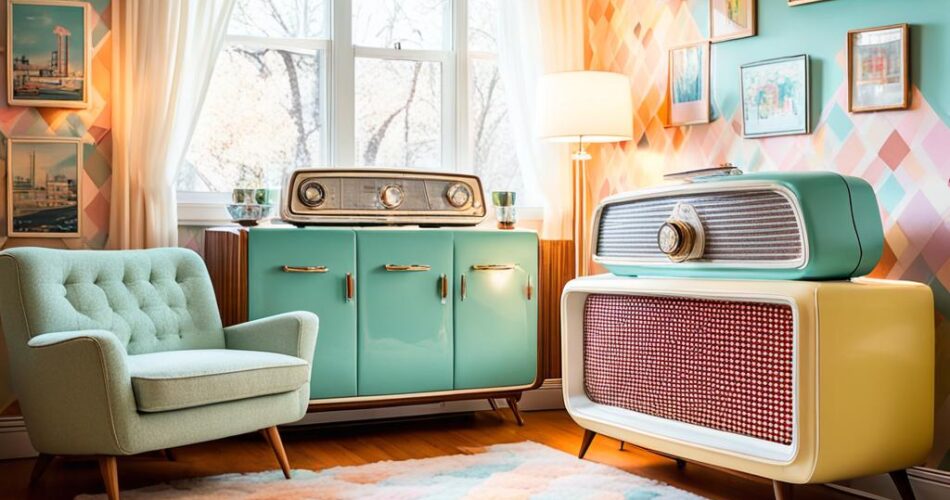The 1950s brought a wave of vintage furnishings and retro interiors that still catch the eye of design lovers. This era saw the rise of mid-century modern design, known for its sleek furniture and organic shapes. Homes during this time mixed bold colors with softer hues, showing the post-war optimism.
Pinterest is a great place for finding 1950’s home decor ideas. It offers a wide range of inspiration, from pastel kitchens to atomic age living rooms. You can easily find ideas for adding a vintage touch to your home, making it feel like a mid-century dream.
A 1,350 sq ft house in Orange County, California, is a perfect example of 1950s architecture. Designed by Palmer & Krisel for Midwood Construction Co., it shows off the era’s design style. It also highlights features like breakfast nooks and bright colors, giving us a peek into the past.
Key Takeaways
- Mid-century modern design dominated 1950’s home decor
- Bold colors and pastels were popular in retro interiors
- Pinterest is a great resource for vintage furnishing ideas
- Authentic 1950s homes offer valuable design inspiration
- Mixing vintage elements with modern touches creates a unique aesthetic
The Rise of Mid-Century Modern Design
The 1950s brought a new era of design to American homes. Mid-century modern design became popular with its clean lines and organic shapes. This style came from a mix of post-war optimism and new technology.
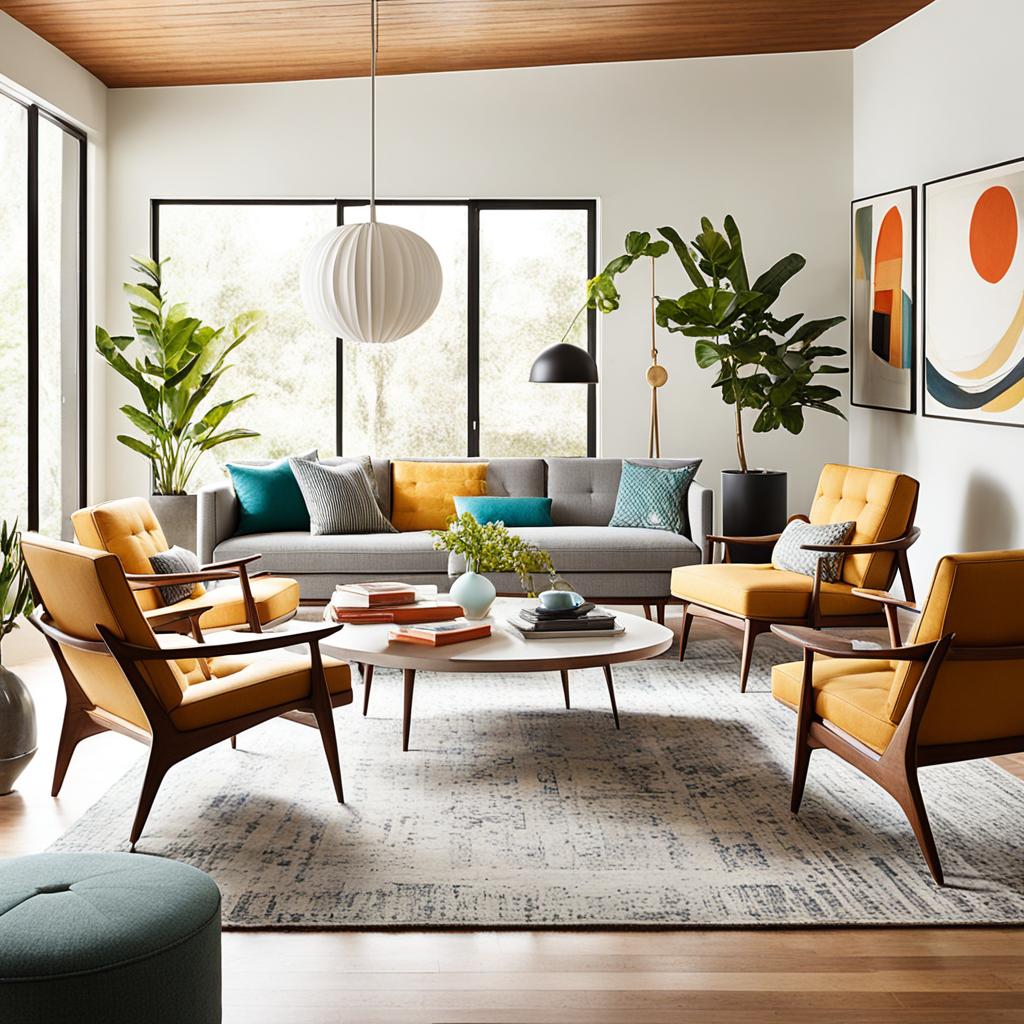
Scandinavian design greatly influenced mid-century modern style. It brought simplicity and functionality to American homes. Teak furniture became a key part of this style, loved for its warm look and strength.
Designers like Charles and Ray Eames made a big impact. Their Eames furniture, like the molded plywood chair, became classics. These designs were both stylish and comfortable, appealing to many homeowners.
“Good design is a combination of high art, hard science, and pure passion.” – Charles Eames
Boomerang shapes and starburst motifs became big in design. They were seen on coffee tables and wall clocks. These fun shapes added a playful touch to the sleek interiors of the time.
| Key Features | Popular Materials | Iconic Designers |
|---|---|---|
| Clean lines | Teak | Charles and Ray Eames |
| Organic shapes | Plywood | Eero Saarinen |
| Functionality | Fiberglass | George Nelson |
The 1949 “California Design” exhibition helped make mid-century modern design famous. It showcased new furniture and home goods, sparking interest. This event started a design movement that changed American homes for many years.
1950’s Home Decor: Embracing Post-War Optimism
The 1950s brought a new wave of home decor, filled with hope and growth after the war. Companies like Herman Miller and Knoll International led the way. They made stylish furniture that was also affordable and well-made, using new materials.
Vibrant and Pastel Color Palettes
Colors became a big deal in the 1950s. Bright colors like turquoise and coral made homes lively. Pastel colors added a gentle touch, showing the era’s happy mood.
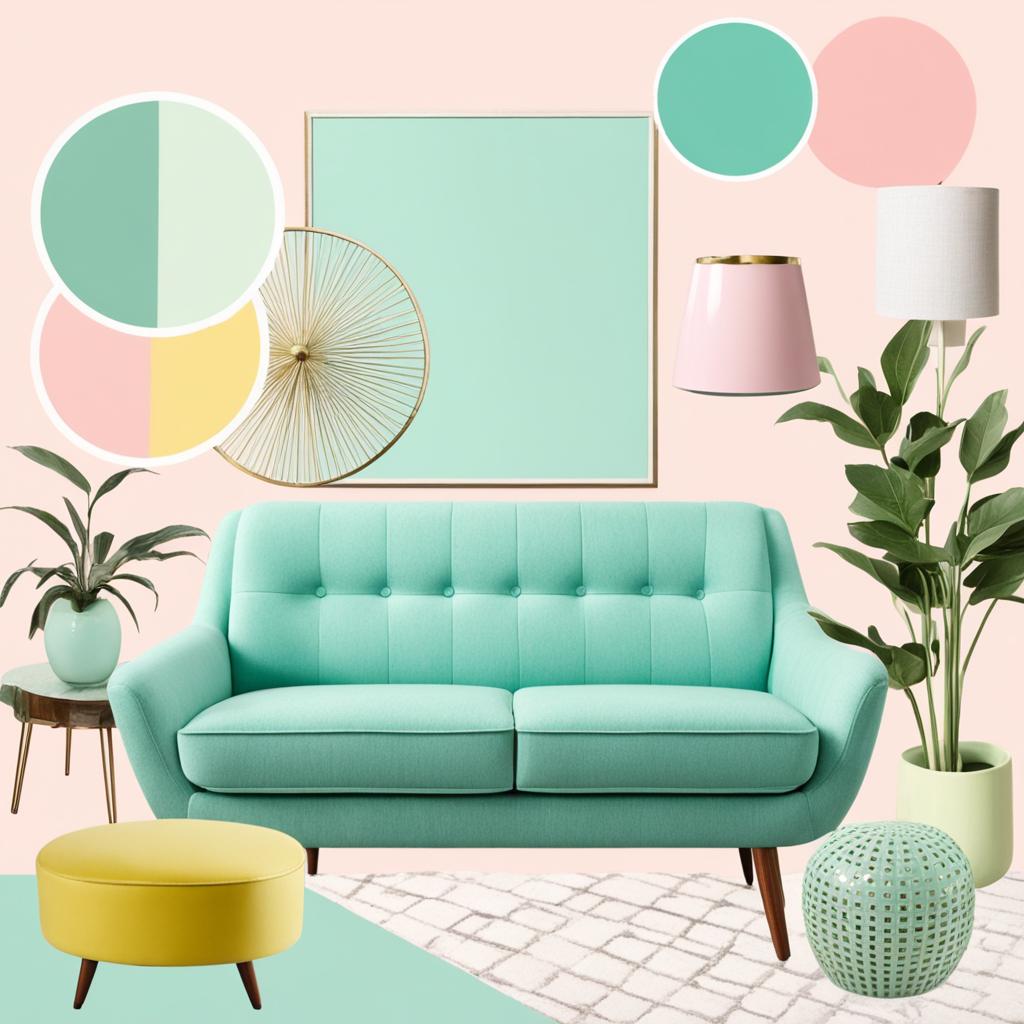
Sleek Furniture Silhouettes
Furniture got a modern look with clean lines and organic shapes. Italian designers set new trends with their innovative materials and tech. Scandinavian designers mixed natural materials with modern tech, creating furniture that was both cozy and modern.
Iconic Design Elements
The 1950s introduced design elements that still shape our style today. Things like starburst clocks, sunburst mirrors, and abstract art became popular. Chrome accents and sputnik light fixtures added a space-age feel. Googie architecture also influenced home design, adding a futuristic touch to everything from coffee tables to TV stands.
“Design should do the same thing in everyday life that art does when encountered: amaze us, scare us or delight us, but certainly open us to new worlds within our daily existence.” – Arthur Erickson
Midcentury modern design is back in style today. People love its mix of practicality, clean lines, and fun touches. It makes spaces that feel both nostalgic and modern.
Bringing the Atomic Age into Your Living Room
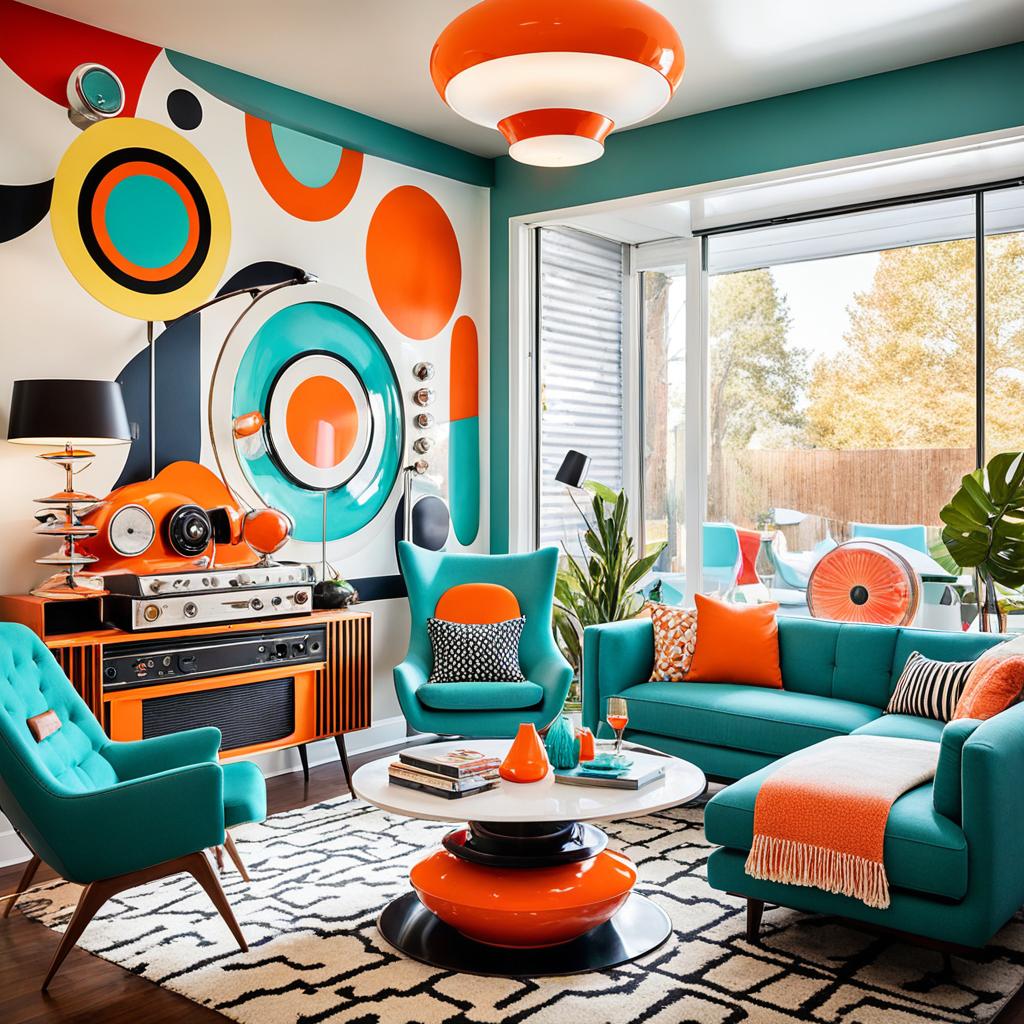
The 1950s brought a new wave of design to homes. Retro living rooms started to look like they were from the future. The George Nelson Ball Wall Clock, from 1949, became a key piece, with its spheres looking like they were floating.
Clean lines and organic shapes were big in furniture design. Kidney-shaped coffee tables were all the rage, adding a soft touch to the sharp lines of the era. Shag carpeting brought warmth and texture, making the space feel cozy.
Colors were bold in atomic design. Bright blues, oranges, reds, and yellows filled rooms with life. Chrome and powder-coated steel added a touch of space-age sparkle to retro living rooms.
“The Atomic Age aesthetic reflects a period of innovation and technological advancements in furniture and decor.”
To bring this look back, think about these things:
- Geometric patterns in upholstery and curtains
- TV consoles as focal points
- Eames Hang-It-All coat rack (introduced in 1953)
- Starburst motifs, like the Franciscan Ceramics pattern from 1954
| Atomic Age Element | Description | Year Introduced |
|---|---|---|
| George Nelson Ball Wall Clock | Iconic timepiece with orbiting spheres | 1949 |
| Eames Hang-It-All | Colorful coat rack with atomic-inspired design | 1953 |
| Franciscan Starburst Pattern | Popular atomic motif in ceramics | 1954 |
Adding these elements can make your living space feel like it’s from the 1950s. It captures the era’s optimism and innovation. The Atomic Age still influences modern design, showing that great design never goes out of style.
The Heart of the Home: 1950’s Kitchen Marvels
Step into a 1950s kitchen and you’ll enter a world full of vibrant colors and new designs. The post-war era brought a wave of optimism and creativity to home decor, especially in the kitchen.
Colorful Appliances and Chrome Accents
Vintage appliances in pastel shades were everywhere. Fridges, stoves, and even microwaves (which started in 1955 at $1,300) came in bright colors. Chrome accents added glamour, showing the era’s love for space-age looks.
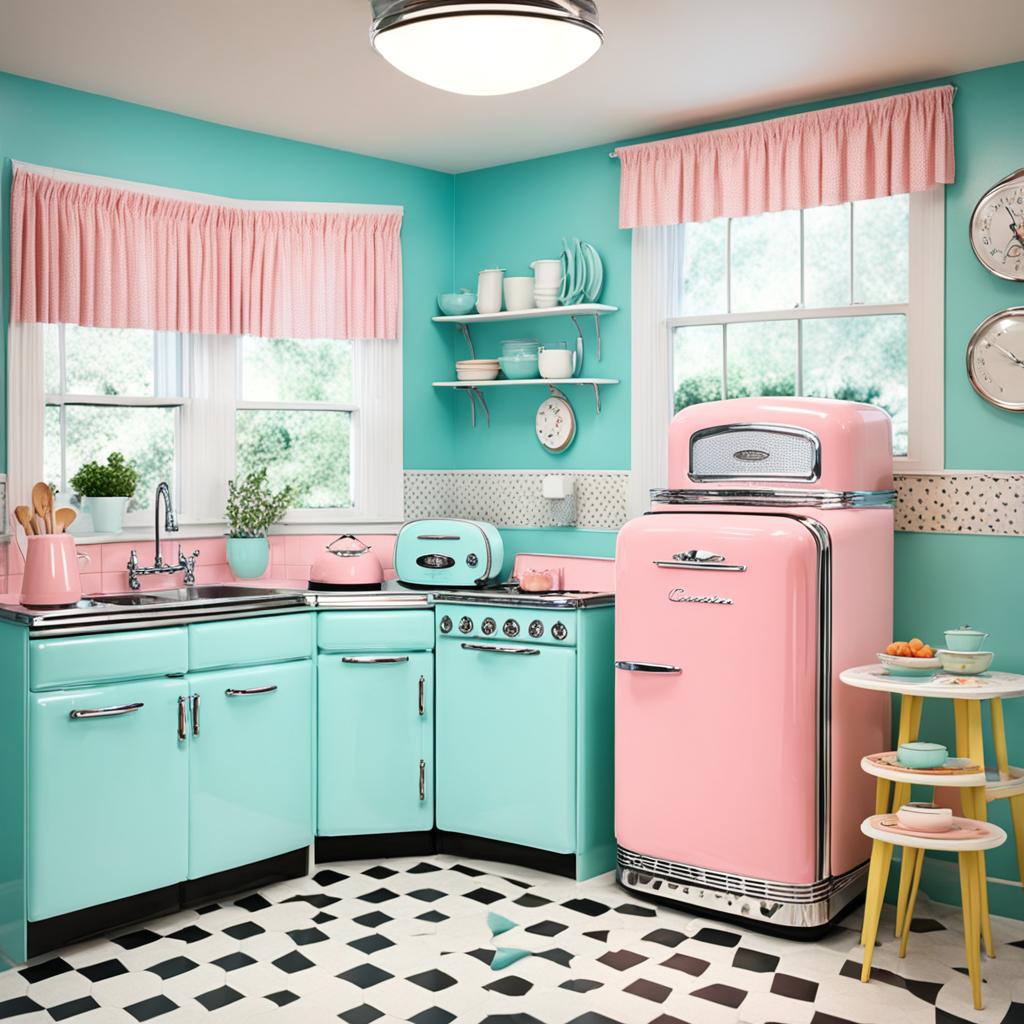
Formica Countertops and Checkered Patterns
Formica countertops changed kitchen design with their durability and easy care. They came in many patterns, often with checkered linoleum floors. This mix created a lively, retro feel that’s still loved today.
Family-Friendly Layouts and Breakfast Nooks
The 1950s kitchen focused on family time. Open layouts connected the cooking area to the living space, and cozy breakfast nooks had built-in benches for casual meals. Many homes also had a kitchenette for quick snacks and coffee breaks.
| 1950s Kitchen Feature | Modern Equivalent |
|---|---|
| Combination washer-dryer | Common in Europe, less so in U.S. |
| Self-propelled vacuum | Robot vacuums |
| All-in-one kitchen gadget | Thermomix (popular in Europe) |
| Induction cooktop | Modern induction stoves |
Some 1950s kitchen dreams didn’t come true in the U.S., but many of its design elements still inspire today’s homes. From colorful appliances to family-focused layouts, the 1950s kitchen’s charm endures.
Retro Bedroom Bliss: Creating a 50’s Sleep Sanctuary
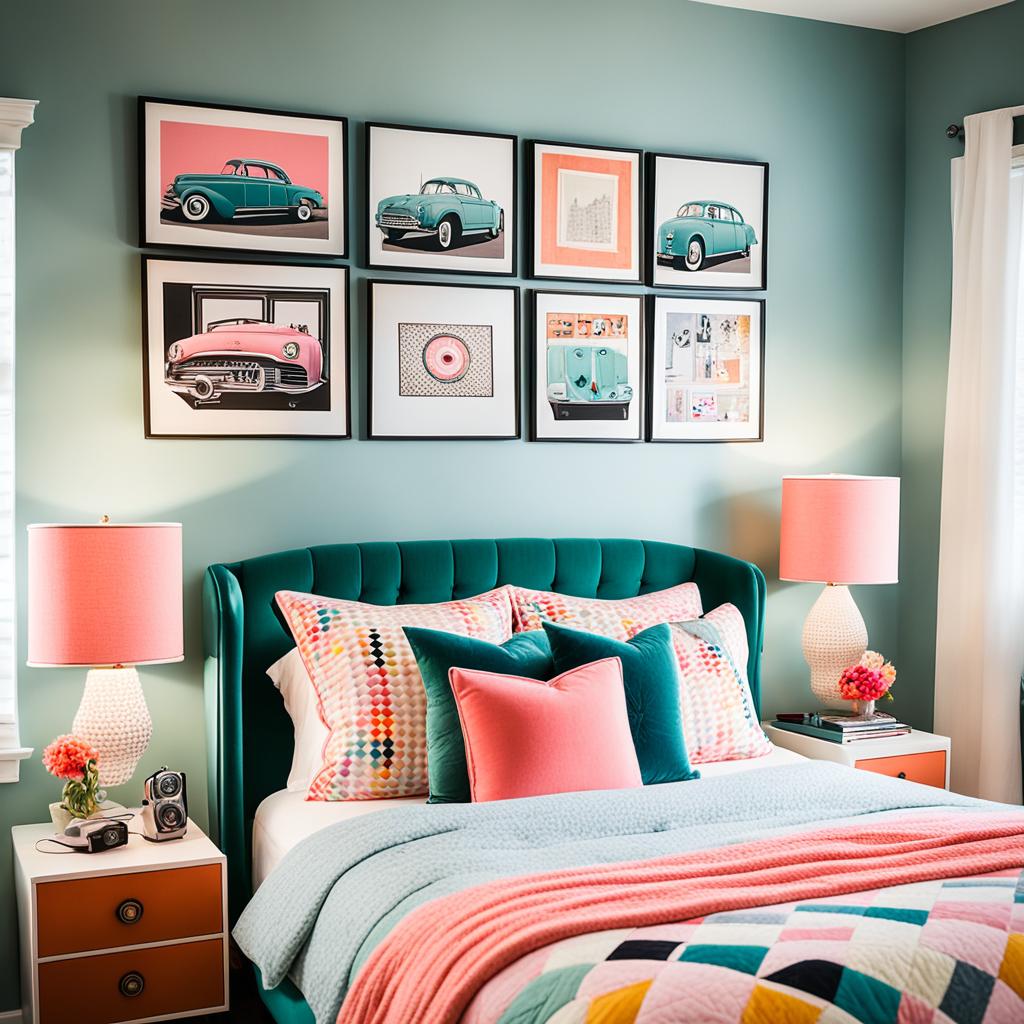
Step into a world of nostalgia with 1950s-inspired vintage bedroom decor. The atomic era style adds a unique charm to your sleep space. It combines comfort with timeless elegance. Embrace the past for a cozy retreat that reflects the post-war era’s optimism.
Mid-century modern furniture is key for a 50s bedroom. Sleek dressers and nightstands with tapered legs add sophistication. The star piece? An upholstered bed with tufted upholstery, often in pastel colors or bold patterns.
Accessorize your vintage haven with iconic pieces:
- A vanity table with a large mirror for that Hollywood glamour
- Sputnik-inspired light fixtures for an atomic touch
- Crocheted blankets and retro fabrics for texture and warmth
- Whitewashed boards to instill a vintage vibe
Create a gallery wall with vintage prints or add an antique clothes mannequin for a practical yet decorative touch. Mix old-fashioned fabrics with distressed furniture for that perfect vintage boudoir look.
“The 1950s bedroom was a perfect blend of comfort and style, reflecting the era’s optimism and flair for design.”
For the ultimate retro feel, consider silky bedding in delicate floral prints or ruffle bedding that echoes vintage dresses. Soft, vintage-inspired lighting adds warmth and serenity to your 50s sleep sanctuary. It takes you back to a bygone era of timeless elegance.
Vintage Bathroom Charm: Pastel Tiles and Bold Fixtures
Step into a time capsule with a 1950s-inspired bathroom! These retro spaces blend pastel tiles, bold fixtures, and space-saving designs. They create a nostalgic yet functional oasis. Let’s explore how to bring this vintage charm into your home.
Colorful Tile Combinations
The heart of a 1950s bathroom lies in its vibrant tile work. Pastel tiles in pink, mint green, or baby blue were all the rage. Mix and match these hues for a playful look. For a bold statement, pair pastel tiles with black accents. This combo evokes the spirit of drive-in theaters and poodle skirts.
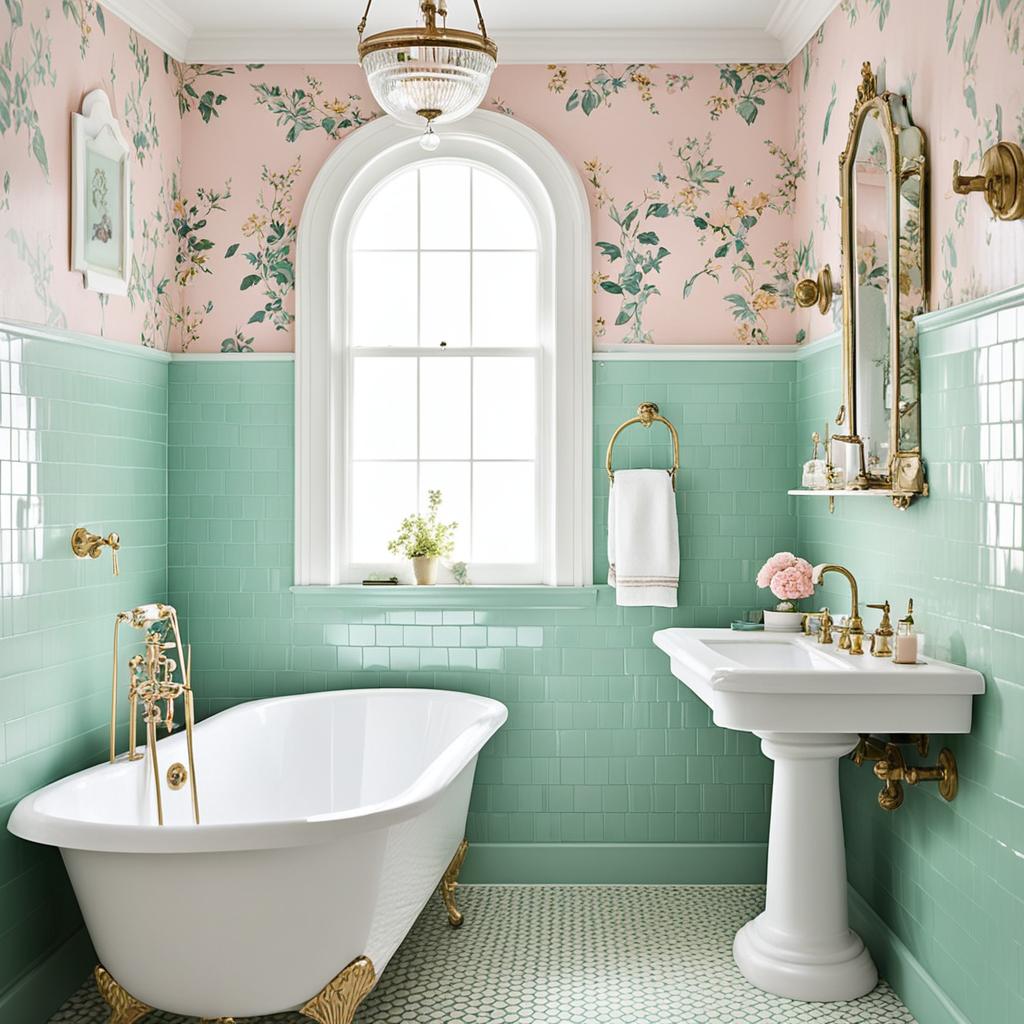
Space-Saving Designs
1950s bathrooms often embraced clever space-saving designs. Wall-mounted sinks and toilets free up floor space. Built-in storage nooks keep essentials tidy. Consider a corner shower to maximize every inch. These smart solutions prove that small can be stylish!
Vintage Accessories and Fixtures
Complete your retro bathroom with authentic touches. Chrome details on faucets and towel racks add sparkle. Vintage bathroom accessories like ceramic soap dishes and toothbrush holders bring charm. Don’t forget a patterned shower curtain and fluffy bath mat to tie it all together.
| Era | Color Palette | Key Features |
|---|---|---|
| 1950s | Pastels (pink, mint, blue) | Chrome fixtures, bold patterns |
| 1960s | Bold (orange, lime green, blue) | Geometric patterns, statement wallpaper |
| 1970s | Earthy (gold, orange, olive) | Natural materials, wood accents |
With these elements, you’ll create a bathroom that’s both functional and full of retro flair. Embrace the optimism of the 1950s in your own home sanctuary!
The Magic of Textiles: Patterns and Fabrics of the 50’s
The 1950s brought a big change to home decor in America. Vintage textiles were full of bold colors and patterns. These showed the era’s hope and new tech advances.
Geometric shapes and atomic patterns were big, inspired by science and the space race. Boomerang patterns and abstract designs made curtains and furniture stand out. New fabrics like nylon, polyester, and acrylic changed the game. They were easy to care for and lasted a long time.

Top designers made their mark on 50s textiles. Lucienne Day’s ‘Calyx’ print featured abstract plants. Eszter Haraszty’s designs were full of creativity. Robert Stewart’s work was a hit in Great Britain, adding to the era’s unique style.
| Fabric Type | Characteristics | Popular Use |
|---|---|---|
| Nylon | Strong, durable | Hosiery |
| Polyester (Dacron) | Shrink-resistant, shape-retaining | Everyday clothing |
| Acrylic (Orlon) | Wool substitute | Sweaters, outerwear |
| Barkcloth | Textured, durable | Upholstery, curtains |
The 50s saw a big rise in automatic washing machines, with sales tripling from 1950 to 1956. This mix of new tech and ease changed how Americans dressed and decorated. It left a big mark on interior design.
Lighting Up the Past: Iconic 1950’s Lamp Designs
The 1950s were a time of big changes in lighting design. These lamps were not just for lighting; they were art pieces. They showed the era’s hope and interest in space.
Sputnik Chandeliers and Space Age Influences
Sputnik chandeliers were all the rage in the 1950s. They were named after the Soviet satellite and had many arms with globe-shaped bulbs. These lamps brought a bit of the stars into American homes.
Tripod Floor Lamps and Mushroom-Shaped Table Lamps
Tripod floor lamps were popular for their modern look and usefulness. Mushroom lamps added a fun element to rooms. These lamps often had a brass finish, thanks to designers like Paavo Tynell. His work even caught the attention of companies like Lightolier.
Colorful Glass and Plastic Lamp Shades
The 1950s loved bright colors. Lamp shades in bold colors and fun patterns brightened up homes. Made from glass or plastic, these shades came in many shapes and sizes. They often had designs that looked like starbursts or atoms, showing the era’s love for the Atomic Age.
